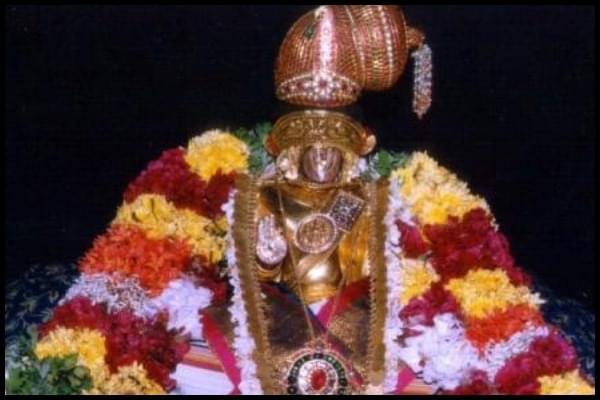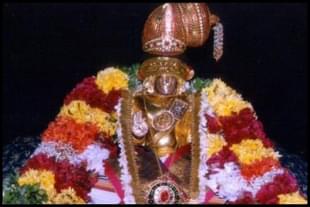Ideas
Nammazhwar: The Saint of All Times
Aravindan Neelakandan
Jun 06, 2020, 01:46 AM | Updated 01:45 AM IST
Save & read from anywhere!
Bookmark stories for easy access on any device or the Swarajya app.


In the Sri Vaishnava Hindu tradition, Nammazhwar is considered as the seer ‘who made Vedas Tamil.’
His hymns ,1296 in all, define the essence of the Sri Vaishnava philosophy.
He is the commander of the divine army of Vishnu.
He was born in a small town of southern Tamil Nadu, today known as Aazhwar Thirunagari, to the Vellala clan.
It is said that the child with the divine radiance was also totally silent, much to the distress of the parents. It was when Mathurakavi Aazhwar came to this town, guided by the divine radiance, very much like the ship guided by the light of the watch tower, and asked him a question with a deep philosophical connotation, that the child answered with a crisp yet profound reply.
Then, there was no stopping.
His Thiruvaaimozhi – utterances from the auspicious mouth of the Aazhwar, is among the greatest achievements by any spiritual treatise.
In terms of mystic depth and expanse, as well as in terms of literary aesthetics, the hymns excel.
It is said that the learned poets of Madurai objected to the praises heaped on Nammazhwar. But when they at last read just a few lines of his, they realised his greatness. So, they all sang a verse in praise of him and surprisingly, all the verses turned out to be the same one.
In that, they said that any composition, if in front of a single word from the poems of Nammazhwar, would look like a firefly before the magnificence of the Sun, a ghoul dancing before the celestial nymph Rambha, a dog before a tiger, and a fox loitering before the majestic walk of a lion.
The beauty of Sri Vaishnavism is that it sees the entire universe as the body of the Divine. At the same time, it also sees the Divine as greater than all the universe.
True to the adage that Nammazhwar is the ‘Maaran who made Vedas Tamil’, he presented in stunning poetry the amazing functional conception of the Divine enshrined in the Vedas.
Here, we see three well known verses of Nammazhwar, each enshrining in them sacred ecology, theo-diversity and samanvaya, respectively.
Sacred Ecology
Enshrined in the effulgent Vedas is
He who swallowed the Universe,
who like life in the body is
hidden yet pervades all existence evolving
right from the very elements primordial

Here, Nammazhwar starts with Vishnu as the deity of the Vedas. He is inside the Vedas.
And Vedas as yajna represent the functional universe.
So, when all the names and forms get dissolved ultimately, what remains is the truth, the sat.
Hence, the Aazhwar points out in past tense that Vishnu was the one who consumed all the universe and after the dissolution he alone remained. By making this past tense, he also points out the cyclic nature of evolution and dissolution of existence.
Then, he proceeds to the current existence.
In this, Vishnu is hidden and is all-pervading in the entire cosmos. It is not like he created and then entered them like a ghost in the machine but right from the primordial elements, the five elements for them and perhaps quarks for us, he is hidden and all-pervading.
Nammazhwar says he is like that as life pervades all body.
This analogy is striking.
Unlike the conception that the vital principle is aloof from the body and resides in a separate way, for Nammazhwar the vital principle is thoroughly pervading all the body.
With this, the entire existence becomes the body of the Divine where he pervades and lives – from the smallest quark to the largest galaxy.
For us, this makes every natural object his body. This makes it mandatory that we respect nature as divine. Nammazhwar can thus be considered as the father of sacred ecology.
Theo-Diversity
Each one as it befits the understanding of each,
Worships the Divine in any form one adores;
Such divine forms thus adored
Fulfil without any deficiencies
For those who adore, the destiny of each

The verse can allow for multiple interpretations but all of them emphasise that diverse forms of worship should not be condemned.
Here, Nammazhwar emphasises that each person chooses his or her form of worship as per the individual understanding and needs. It would be wrong to say that one form of worship is superior to another. The worship of every person is thus without deficiencies.
Interestingly, the entire theological exercise of Christian institutions, even in modern times, or perhaps especially in modern times, is to prove that all religions, even if good, are somehow deficient and that it is only in Jesus that there is fulfilment.
Here, Nammazhwar rejects these kind of fulfilment theologies with which one set of believers tend to emphasise their monopoly over truth.
Even in the traditional Sri Vaishnava interpretation, where all other divine forms are seen as that of deities lower than Vishnu, it is accepted that it is Vishnu, who, being the ‘antaryami’, or the inner personal principle in all these deities, fulfils the demands of the devotees worshipping ‘other’ gods and goddesses.
So, other deities are not seen as ‘false’ or evil or Satanic.
The general understanding of this verse, which has become part and parcel of the Hindu pluralist culture, particularly in Tamil Nadu (and through Sri Ramanuja, throughout India), is that one should worship the Divine in any form but condemn none’s deity as inferior; for, to all sincere devotees of all deities, it is Vishnu who provides grace through those forms.
Thus, the verse makes it mandatory for a Sri Vaishnava not to indulge in monopolistic expansionism and protect the theo-diversity.
Samanvaya
Insist as existing, in all manifest forms is He
Insist as not existing, all non-existence is He
Claimed as Existing and not-Existing
Both in the binary of existence, non-existence
He pervades ceaseless all there is and is not.

At the outset, we see that the binary of atheism and theism are harmonised here.
Dig a little deeper, and we see the typical extraordinary grasp of Hindu Vedic rishis over the binary of existence and non-existence.
They are not opposites but they are complementary.
The famous Nasadiya Sukta points out the complementary nature of non-existence and existence.
The so-called heterodox systems, like Jainism, emphasise on this non-existent and undefinable substratum of reality.
According to A.L. Basham, all the so-called non-Vedic sects, including the Ajivika sect, ‘were reviving in one way or another the Vedic concept of rta, but incorporating with it an atheistic or impersonal first principle, posited a framework of karmic cause and effect, within which the soul moved.’
So, when Nammazhvar integrated the theistic and the atheistic, the existence and non-existence, and the personal and the impersonal through this verse, he also created the space for samanvaya.
Atheism can be accepted.
Heterodox streams of spirituality can be accepted.
They can be seen by Sri Vaishnavaites as not false and streams to be opposed but another form of the quest for realisation and animated by the same Divine that is within the spiritual thirst of a bhakta.
It is this approach, initiated through such simple, lucid, yet profound verses of Nammazhvar, that should be credited when we see such samanvaya in action in the later testing times of history.
This is seen in the inscription related to Bukka, one of the pioneers of the Hindu resistance to Islamist aggression in the south, and the founders of the Hindu empire of Vijayanagara.
How did the king who himself belonged to the Vedic tradition settle the conflict between Vaishanavas and Jains?
This is what the Shravanabelagola inscription states:
Dispute having arisen between the Jainas and Bhaktas (of Vishnu), the Bhavyajanas (the Jainas) of all the Nadus… having made petition to ViraBukkaraya, about the injustice done by the Bhaktas, the king taking the hand of the Jainas and placing it in the hand of the Sri-Vaishnavas of the eighteen Nadus, including all the Acharyas (religious teachers) of the places… and declaring (at the same time) that there was no difference between the Vaishnava Darshana and the Jaina-Darshana.
If loss or advancement should be caused to the Jaina-Darshana through the Sri-Vaishnavas, the Sri-Vaishnavas will kindly deem it as loss or advancement caused to their own (Darshana). The Sri-Vaishnavas will to this effect kindly set up a Shasana (inscription) in all the Bastis (Jain worshipping places) of the kingdom. For as long as the sun and the moon endure, the Sri-Vaishnava creed will continue to protect the Jaina-Darshana. The Sri-Vaishnavas and the Jainas are one (body); they must not be viewed as different.C. Panduranga Bhatta, Contribution of Karnataka to Sanskrit, Institute of Asian Studies, 1997, p.267
For an outsider this may look very paradoxical.
How can a system that does not accept Vedas and even a supreme deity coexist with a Vedic dharma that insists on Vishnu as the supreme personality of the Godhead?
The answer lies then in the roots of Sri Vaishnavism where Nammazhwar has harmonised existence and non-existence not just in an abstract philosophical level, but in the common spirituality of the collective psyche.
The seemingly opposite binaries become complementary in Vishnu whose body is the whole universe.
4 June, Thursday, was Vaikasi Visakam, the birth day of Nammazhwar, one of the greatest seer-philosopher-poets of India.
His hymns are another treasure Tamil has been blessed with.
Their fruit is Sri Vaishnavism, which in turn created the Bhakti movement during the medieval times; which in turn gave birth to Shivaji and the Khalsa.
And all that started in the small town of southern Tamil Nadu, where a child was in meditation. Without speaking.
Until Mathurakavi Aazhwar arrived.
Aravindan is a contributing editor at Swarajya.





